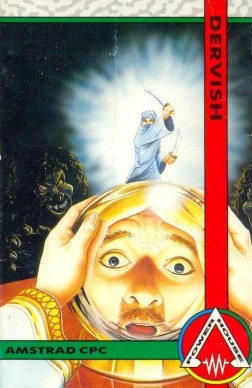Difference between revisions of "Dervish"
(Modified infobox, cover gallery and links to CDT file and CPC-POWER) |
(Rewrote paragraph relating to Amstrad Drumkit type-in, and modified link to March 1986 issue of Amstrad Action) |
||
| (3 intermediate revisions by the same user not shown) | |||
| Line 15: | Line 15: | ||
|} | |} | ||
| − | == | + | '''''Dervish''''' is an arcade game that was released by [[The Power House]] in 1988. The gameplay is very similar to ''[[Druid]]'', which was released by [[Firebird]] in 1986. The aim of the game, according to the text on the inlay, is to "journey through the eight levels of Awareness to reach the Upward Path", by using weapons and spells. In addition to a normal playing mode, there is also an Explore mode that allows the player to explore the levels freely without dying; however, the player cannot score any points. |
| + | |||
| + | The programmer, John Keneally, was also responsible for several type-ins that were published in ''[[Amstrad Action]]'', including the popular ''Amstrad Drumkit'', which was originally published in the [[Amstrad Action March 1986 Type-Ins|March 1986]] issue (#6) and was later published on two of their covertapes. | ||
| + | |||
| + | == Reviews == | ||
| + | |||
| + | ''Amstrad Action'' reviewed the game in the [[Amstrad Action, Issue 32, May 1988|May 1988]] issue (#32), and gave it an overall rating of 66%. Their review remarked that "the graphics are bright and colourful with smooth four way scrolling", "sound effects are of average quality and the title tune is just about tolerable". It summarises that "if you want originality then you might as well look elsewhere, but if you enjoyed ''Druid'' then this should keep you occupied". | ||
| + | |||
| + | ''[[Computing with the Amstrad|Computing with the Amstrad CPC]]'' reviewed the game in the June 1988 issue (Vol. 4 No. 6), and were much less impressed, giving it an overall rating of just 20%. Among their comments are that "the graphics are pretty awful", "the scrolling is flickery", "the music on the title screen is prehistoric and the in-game sound effects wouldn't be missed", and "this Power House game has about as much power as a deflated balloon". | ||
| + | |||
| + | {|{{Prettytable|width: 700px; font-size: 2em;}} | ||
| + | |AA:||May 1988 (#32)||Page 54||66% | ||
| + | |- | ||
| + | |CWTA CPC:||Vol. 4 No. 6 (June 1988)||Page 26||20% | ||
| + | |- | ||
| + | |} | ||
| + | |||
| + | == Covers == | ||
<gallery caption="Dervish"> | <gallery caption="Dervish"> | ||
| − | |||
Image:Dervish (K7) (The Power House) (1988) (Standard Jewel Case) - (Front).jpg|Front cover | Image:Dervish (K7) (The Power House) (1988) (Standard Jewel Case) - (Front).jpg|Front cover | ||
| + | Image:Dervish (K7) (The Power House) (1988) (Standard Jewel Case) - (Back).jpg|Back cover | ||
</gallery> | </gallery> | ||
| Line 35: | Line 52: | ||
* [[Media:Dervish (The Power House) (1988) (Standard Jewel Case).cdt.zip|CDT file]] | * [[Media:Dervish (The Power House) (1988) (Standard Jewel Case).cdt.zip|CDT file]] | ||
| + | |||
| + | == Screenshots == | ||
| + | |||
| + | <center><gallery style="clear: both"> | ||
| + | |||
| + | Image:Dervish_TitleScreen.png|<center>The title screen</center> | ||
| + | Image:Dervish_Level1.png|<center>Level 1 - a map is also helpfully provided</center> | ||
| + | Image:Dervish_WeaponSelection.png|<center>Replenishing your supply of weapons</center> | ||
| + | Image:Dervish_Level2.png|<center>Level 2</center> | ||
| + | Image:Dervish_Level3.png|<center>Level 3 - one wrong move and you're dead!</center> | ||
| + | Image:Dervish_Level4.png|<center>Level 4</center> | ||
| + | |||
| + | </gallery></center> | ||
== Links == | == Links == | ||
Latest revision as of 15:24, 25 December 2010
| |||||||||||||||||||||||||||||||||||||||||||||
Dervish is an arcade game that was released by The Power House in 1988. The gameplay is very similar to Druid, which was released by Firebird in 1986. The aim of the game, according to the text on the inlay, is to "journey through the eight levels of Awareness to reach the Upward Path", by using weapons and spells. In addition to a normal playing mode, there is also an Explore mode that allows the player to explore the levels freely without dying; however, the player cannot score any points.
The programmer, John Keneally, was also responsible for several type-ins that were published in Amstrad Action, including the popular Amstrad Drumkit, which was originally published in the March 1986 issue (#6) and was later published on two of their covertapes.
Contents
Reviews
Amstrad Action reviewed the game in the May 1988 issue (#32), and gave it an overall rating of 66%. Their review remarked that "the graphics are bright and colourful with smooth four way scrolling", "sound effects are of average quality and the title tune is just about tolerable". It summarises that "if you want originality then you might as well look elsewhere, but if you enjoyed Druid then this should keep you occupied".
Computing with the Amstrad CPC reviewed the game in the June 1988 issue (Vol. 4 No. 6), and were much less impressed, giving it an overall rating of just 20%. Among their comments are that "the graphics are pretty awful", "the scrolling is flickery", "the music on the title screen is prehistoric and the in-game sound effects wouldn't be missed", and "this Power House game has about as much power as a deflated balloon".
| AA: | May 1988 (#32) | Page 54 | 66% |
| CWTA CPC: | Vol. 4 No. 6 (June 1988) | Page 26 | 20% |
Covers
- Dervish
Tape
- Dervish









